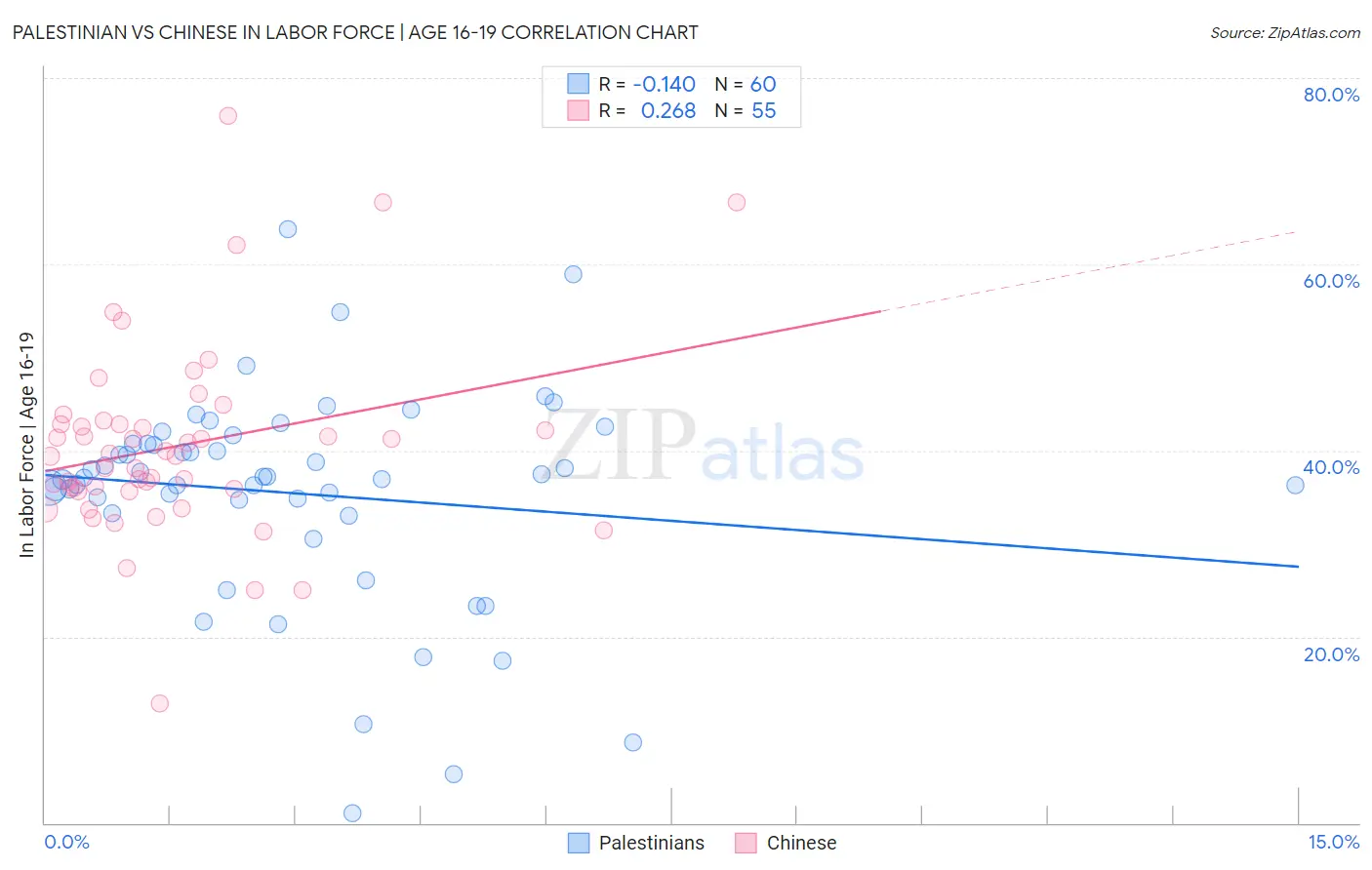Palestinian vs Chinese In Labor Force | Age 16-19
COMPARE
Palestinian
Chinese
In Labor Force | Age 16-19
In Labor Force | Age 16-19 Comparison
Palestinians
Chinese
36.8%
IN LABOR FORCE | AGE 16-19
63.1/ 100
METRIC RATING
168th/ 347
METRIC RANK
38.6%
IN LABOR FORCE | AGE 16-19
98.8/ 100
METRIC RATING
107th/ 347
METRIC RANK
Palestinian vs Chinese In Labor Force | Age 16-19 Correlation Chart
The statistical analysis conducted on geographies consisting of 216,397,857 people shows a poor negative correlation between the proportion of Palestinians and labor force participation rate among population between the ages 16 and 19 in the United States with a correlation coefficient (R) of -0.140 and weighted average of 36.8%. Similarly, the statistical analysis conducted on geographies consisting of 64,804,450 people shows a weak positive correlation between the proportion of Chinese and labor force participation rate among population between the ages 16 and 19 in the United States with a correlation coefficient (R) of 0.268 and weighted average of 38.6%, a difference of 4.9%.

In Labor Force | Age 16-19 Correlation Summary
| Measurement | Palestinian | Chinese |
| Minimum | 1.1% | 12.8% |
| Maximum | 63.8% | 75.9% |
| Range | 62.7% | 63.1% |
| Mean | 35.4% | 40.5% |
| Median | 37.1% | 39.4% |
| Interquartile 25% (IQ1) | 34.0% | 35.7% |
| Interquartile 75% (IQ3) | 40.7% | 42.8% |
| Interquartile Range (IQR) | 6.8% | 7.1% |
| Standard Deviation (Sample) | 11.5% | 10.5% |
| Standard Deviation (Population) | 11.4% | 10.4% |
Similar Demographics by In Labor Force | Age 16-19
Demographics Similar to Palestinians by In Labor Force | Age 16-19
In terms of in labor force | age 16-19, the demographic groups most similar to Palestinians are Arab (36.8%, a difference of 0.030%), Immigrants from Latvia (36.8%, a difference of 0.080%), Immigrants from South Africa (36.8%, a difference of 0.14%), Immigrants from Western Africa (36.9%, a difference of 0.20%), and Yakama (36.9%, a difference of 0.21%).
| Demographics | Rating | Rank | In Labor Force | Age 16-19 |
| Cambodians | 71.5 /100 | #161 | Good 37.0% |
| Immigrants | Jordan | 69.5 /100 | #162 | Good 36.9% |
| Bermudans | 69.3 /100 | #163 | Good 36.9% |
| Immigrants | Kuwait | 68.9 /100 | #164 | Good 36.9% |
| Yakama | 66.9 /100 | #165 | Good 36.9% |
| Immigrants | Western Africa | 66.7 /100 | #166 | Good 36.9% |
| Arabs | 63.6 /100 | #167 | Good 36.8% |
| Palestinians | 63.1 /100 | #168 | Good 36.8% |
| Immigrants | Latvia | 61.6 /100 | #169 | Good 36.8% |
| Immigrants | South Africa | 60.5 /100 | #170 | Good 36.8% |
| Immigrants | Cambodia | 58.4 /100 | #171 | Average 36.7% |
| South Africans | 58.3 /100 | #172 | Average 36.7% |
| Russians | 57.5 /100 | #173 | Average 36.7% |
| Immigrants | Czechoslovakia | 50.0 /100 | #174 | Average 36.6% |
| Natives/Alaskans | 49.0 /100 | #175 | Average 36.6% |
Demographics Similar to Chinese by In Labor Force | Age 16-19
In terms of in labor force | age 16-19, the demographic groups most similar to Chinese are Delaware (38.6%, a difference of 0.030%), Iraqi (38.6%, a difference of 0.050%), Immigrants from Ethiopia (38.6%, a difference of 0.10%), Lebanese (38.6%, a difference of 0.10%), and Immigrants from Eritrea (38.7%, a difference of 0.21%).
| Demographics | Rating | Rank | In Labor Force | Age 16-19 |
| Immigrants | Thailand | 99.1 /100 | #100 | Exceptional 38.7% |
| Hmong | 99.1 /100 | #101 | Exceptional 38.7% |
| Zimbabweans | 99.1 /100 | #102 | Exceptional 38.7% |
| Immigrants | Cameroon | 99.0 /100 | #103 | Exceptional 38.7% |
| Immigrants | Eritrea | 99.0 /100 | #104 | Exceptional 38.7% |
| Iraqis | 98.9 /100 | #105 | Exceptional 38.6% |
| Delaware | 98.8 /100 | #106 | Exceptional 38.6% |
| Chinese | 98.8 /100 | #107 | Exceptional 38.6% |
| Immigrants | Ethiopia | 98.7 /100 | #108 | Exceptional 38.6% |
| Lebanese | 98.7 /100 | #109 | Exceptional 38.6% |
| Maltese | 98.6 /100 | #110 | Exceptional 38.5% |
| Crow | 98.5 /100 | #111 | Exceptional 38.5% |
| Immigrants | Scotland | 98.5 /100 | #112 | Exceptional 38.5% |
| Sub-Saharan Africans | 98.3 /100 | #113 | Exceptional 38.4% |
| Hawaiians | 98.2 /100 | #114 | Exceptional 38.4% |